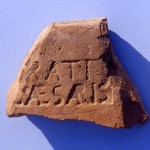The Roman Archaeology Blog is concerned with news reports featuring Roman period archaeology. If you wish to see news reports for general European archaeology, please go to The Archaeology of Europe Weblog.
Monday, November 12, 2012
Were Roman slaves hungry?
What was it like to be a slave in the Roman Empire? The answer, according to the latest excavations at Vagnari, is that slaves were rather better looked after than one might expect: they ate quite well, they suffered less from childhood starvation than did the population in general, and when they died, the grave goods they were buried with suggested that they were certainly not living in abject poverty.
This at least was the implication of research that was revealed in a recent conference held at Edinburgh University organised by Alastair Small on 26th – 28th October 2012, when Alistair Small and his associates told us about their latest work at Vagnari.
Vagnari is the name of an abandoned farmstead – you will not find it on any map, but it lies just outside the town of Gravina, near Bari in Apulia. Here Professor Small has been excavating for nearly 40 years, at first in the nearby hillfort of Botromagno, and subsequently doing field surveys over the whole area which revealed an interesting site at Vagnari: we have already covered the whole history in Current Archaeology 45. But in the Roman imperial period, it appears to have been an imperial estate, centred round a tile works, and one of the tiles was found stamped with the name of Grati Caesaris, which means the work of Gratus, slave of Caesar.
Read the rest of this article...
Subscribe to:
Post Comments (Atom)

No comments:
Post a Comment
Note: Only a member of this blog may post a comment.